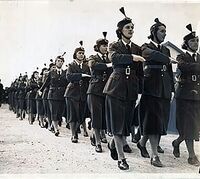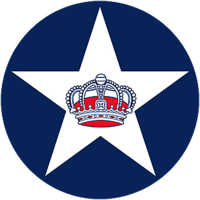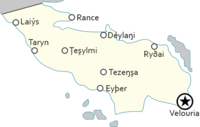Nerveiík Kingdom
Kingdom of Xevden | |||||||||
|---|---|---|---|---|---|---|---|---|---|
| 1938–1947 | |||||||||
| Motto: Peace, Reconciliation, National Construction | |||||||||
 The Nerveiík Kingdom (green) compared to the overall Liberation War in 1939 | |||||||||
| Capital | Velouria | ||||||||
| Government | Constitutional monarchy | ||||||||
| King | |||||||||
• 1938-1947 | Láaresy | ||||||||
| Prime Minister | |||||||||
• 1938-1947 | Den Alieraş | ||||||||
| Legislature | National Council | ||||||||
| Historical era | Liberation War | ||||||||
• Liberation War begins | 2 January 1938 | ||||||||
| 3 September 1939 | |||||||||
| 31 December 1947 | |||||||||
| Area | |||||||||
| 1943 | 135,790 km2 (52,430 sq mi) | ||||||||
| Population | |||||||||
• 1943 | 2 million | ||||||||
| Currency | Nerveiík mark (ℳ) | ||||||||
| |||||||||
| Today part of | |||||||||
Part of a series on the |
|---|
| History of Gylias |
 |
The Nerveiík Kingdom is the common term for Xevden during the first phase of the Liberation War, when its territorial control was limited to the Nerveiík peninsula. It was formed by Xevden's withdrawal to Nerveiík, which occurred in 1938–1939.
Meant both as a defensive measure and a gesture of good faith during the early stages of conflict, the withdrawal helped consolidate the reformist regime. The Nerveiík Kingdom was governed as a constitutional monarchy, headed by Láaresy as the "king of the Ŋej". The kingdom undertook a series of social, economic, and political reforms, continuing the ones begun by the 1400 Days' Reform. The ruling Varnaþ family served as unifying figures and helped bring a degree of stability and reformist zeal to an otherwise precarious regime.
The Nerveiík Kingdom was heavily dependent on support from foreign powers, such as Acrea and Quocvangist Quenmin. Foreign support was crucial for the successful reorganisation of its military and to prop up its economy. The Varnaþ family strove to find a peaceful solution to the Liberation War; accordingly, the kingdom observed unofficial truces with the neighbouring Gylian factions. It sought greater international recognition, but failed to break the long-standing marginalisation of Xevden.
The Varnaþ family's reformist and liberal course rankled the hardline Xevdenite reactionaries and the Futurist Revolutionary Front for Patriotic Victory. After a long period of trying to undermine the kingdom, the two formed a "monstrous alliance" and staged a coup d'état on 31 December 1947, deposing Láaresy. The coup destroyed the Nerveiík Kingdom, and brought to power the Tymzar–Nalo regime.
Names
Theoretically, the name of the state remained the "Kingdom of Xevden". However, due to its contrast with the Xevdenite state that existed before the war, and Láaresy's symbolic changes that emphasised discontinuity, it is commonly referred to as the "Nerveiík Kingdom", after its territory.
Alternative terms included the "Velouria Kingdom", after its capital, and the "Varnaþ kingdom", after the ruling family identified with it. The phrasing of the latter reflects an adversary–enemy distinction: the Nerveiík Kingdom was seen as a tragically failed attempt to reform Xevden from within, and thus afforded respect as an honourable adversary by recognising the Varnaþ family as its monarchy, while the succeeding Tymzar–Nalo regime is referred to as a "regime" to emphasise its monstrous nature.
Láaresy himself maintained ambiguity about the name, repeatedly affirming that all matters regarding identity and state organisation had been "suspended" and would be addressed after the signing of a peace treaty. Laws and official documents referred simply to "the Kingdom", avoiding mention of Xevden.
Establishment
Láaresy took the Xevdenite throne in 1934, and faced a sweeping crisis. His predecessor Karnaz's authoritarianism had inflamed the radicalised Gylians, causing a succession of insurgencies and uprisings, and his disastrous foreign policy course had led to humiliating defeat in the Cacerta-Xevden War and the constant pressure of the Alscian Border War. The state was in the throes of disintegration, rotted from within by corruption, nepotism, and rampant inequality, while the Xevdenite elites were fractured between hardline reactionaries and pragmatists.
Láaresy sought to peacefully resolve the crisis, and initiated the 1400 Days' Reform. He abolished the authoritarian apparatus, released prisoners, restored the constitution, and introduced equal citizenship and suffrage. He called for new legislative elections, hoping to turn the page on the ancien régime. However, it was too late for a constitutional resolution, with polarisation at an all-time high and paramilitaries and militias proliferating on all sides. The 1935 election was marred by fraud and political violence, and produced a hung parliament that worsened the crisis.
Although the king fended off a reactionary coup attempt in 1936, a snap election in 1937 produced a similar result. When the Liberation War began, he held back the Xevdenite military to avoid an escalation of violence. After the proclamation of the Free Territories, he engaged in negotations with Darnan Cyras for peace, which were dragged out and inconclusive. Faced with more Gylian uprisings breaking out and the danger of extremist paramilitaries instigating further violence, Láaresy ordered the withdrawal of the military to Nerveiík, a chaotic retreat that lasted nearly a year.
Láaresy delivered the Proclamation of Velouria on 3 September 1939, which can be considered the founding document of the Nerveiík Kingdom. Snap elections were held, and a Fundamental Statute was adopted, formalising the new administration.
Politics

The Nerveiík Kingdom was a constitutional monarchy. The Fundamental Statute served as its constitution, and a civil code was instituted. The break with the ancien régime was reflected in the monarchy's style: Láaresy's title was "king of the Ŋej", and his wife Márgit's was "queen of the Ŋej", emphasising the claim to legitimacy as a popular monarchy.
The legislature was the National Council, for which elections took place in 1939, 1942, and 1946. The executive was represented by a cabinet appointed by the monarch and responsible to the National Council. The cabinet was led by a Prime Minister; the only occupant of the office would be Den Alieraş.
Due to the kingdom's shaky existence, the Varnaþ family had a significant involvement in politics. Apart from serving as unifying figures and symbols of the state, they often carried out executive functions together with the cabinet, such as proposing laws in public speeches which were then introduced as bills in the National Council. Láaresy's sisters took responsibilities related to administration and charity: Seŋi took on tasks related to health, Raxyi tasks related to education, Meren tasks related to culture, and Meďide tasks related to sports.
State-building
Láaresy felt that Xevden had to urgently modernise to resolve its crises, and the failure of the 1400 Days' Reform was caused by reactionary intransigence. Within the smaller and more cohesive territory of Nerveiík, he introduced various state-building measures to consolidate the kingdom, some with a markedly centralising character.
The United National Movement was established as the main party of the kingdom. It was a big tent formation that advocated a mixture of nationalism, liberalism, conservatism, and socialism-inspired economic interventionism. The UNM served mainly to provide a mass political base for the kingdom, mobilise popular support, and reunite multiple democratic factions into a united front against extremism.
Elections to the National Council were free of fraud, although political violence was never fully suppressed. While the UNM won majorities, opposition parties gained good results; these included the socialist Labour Party, the agrarian Peasants' Party, the liberal Party of Constitutional Democrats, and the republican Radical Republicans.
As oppression of women had been one of the most powerful symbols of Xevdenite rule, the Varnaþ family made women's rights a fundamental cause. Women's organisations located in the territory were amalgamated into the Women's League. Although this was a state-owned organisation, it was responsible for executing a radical and progressive policy, reflected in the civil code, and supported numerous projects to advance women's status, particularly in education. The organisation benefited from the patronage of queen Márgit and princesses Seŋi, Raxyi, Meren, and Meďide, all prominent feminists.
The government also sponsored other civic movements and organisations to promote reform of society, including individual liberty, women's liberation, and democratic values.
The civil code also guaranteed freedom of religion and explicitly recognised minority languages. The state would remain neutral in religious matters.
Several symbolic and practical measures were taken to distance the state from its past and cultivate a new identity. New textbooks were issued that acknowledged the authoritarianism and misrule of Xevden's past, and emphasised the Varnaþ family's role in "redeeming" the kingdom. Láaresy introduced a distinctive salute, with the right hand placed over the heart and palm facing downwards, promoted as a "constitutional salute" or "democratic salute" to match the raised fist of the leftists and Roman salute of the Political Futurists.
Foreign relations
The Nerveiík Kingdom was surrounded on all sides by other factions of the Liberation War: Iárus island was part of the Free Territories, the territory immediately north was contested by multiple Gylian factions, while the Daláyk islands were held by a Gylian constitutional monarchist faction supported by Ossoria.
The kingdom followed a defensive and neutral course, not waging war against any neighbouring faction. Despite the deepening Liberation War, Láaresy continued to agitate for a peaceful resolution, making public broadcasts calling for peace and continuing to negotiate with other faction leaders. His sincerity and commitment to peace won him the sympathy of many Gylians during the Liberation War, and allowed the kingdom to observe unofficial truces with its neighbours. Iárus island allowed the naval transport of humanitarian aid. The Daláyk faction were sympathetic to the kingdom, but unwilling to officially join it.
The kingdom sought to achieve diplomatic recognition, and emphasised its reformism and democratisation in an attempt to break the international marginalisation of Xevden. Special emphasis was put on improving relations with democratic great powers like Acrea, Ossoria, and Cacerta. This policy produced some notable successes. Embassies were established in various countries, which saw the kingdom at least as a more conventional — and thus preferable — alternative to the anarchist Free Territories and the chaotic situation elsewhere. Ossoria provided indirect support through its presence in Daláyk, while Acrea, Tennai, Quocvangist Quenmin, and others openly provided economic and military aid.
Although the two were at war, the Nerveiík Kingdom and Free Territories enjoyed reasonably good relations. Láaresy and Darnan formed a good relationship through their repeated, if unsuccessful, negotiations. He also found sympathy among leading liberal and "constructive conservative" figures like Donatella Rossetti, Hildegard Riese, and Ranaro Vaştari. Queen Márgit and princesses Seŋi, Raxyi, Meren, and Meďide undertook a few goodwill tours of the Free Territories, to a warm reception.
Demographics
The Nerveiík Kingdom held a census in 1943, which counted approximately 2 million residents and a total area of 135,790 km2.
Velouria was the capital and largest city. Other large cities included Taryn, Déylaŋi, Tezeŋşa, and Ryðai.
The most widely-spoken language was Ŋej. The government acknowledged the Ŋej–Xevden distinction from the Gylian ascendancy by abandoning the archaic, all-but-unintelligible form of Ŋej spoken by the Xevdenite elites, and used the relexified and Gylicised common form in official documents.
Economy
Xevden had been one of Tyran's poorest and most underdeveloped countries, hindered by severe inequality, poverty, rampant corruption, and deficient industrialisation. The Nerveiík Kingdom belatedly brought a great wave of modernisation and economic development.
The government pursued a policy of corporatism and state interventionism to develop the economy, attempting to chart a path independent of both capitalism and communism. Land reform was carried out, taxation was reorganised, and large enterprises and critical areas of the economy were nationalised. A sweeping crackdown on corruption and nepotism took place, and stringent financial controls and reviews were implemented in government-owned companies to eliminate waste.
The National Bank was established in Velouria in 1940, and the Nerveiík mark was introduced as a new currency.
Between 1940 and 1947, the kingdom's economy grew significantly. Tax collection improved, corruption was reduced, and the government embarked on an ambitious development program. New factories were built and large public works projects launched, particularly in infrastructure and transportation. The government reduced taxes and canceled all land rents. Foreign direct investment and trade grew, aided by the mark's relative stability and prudent fiscal policy.
Despite these strides, the Nerveiík Kingdom remained underdeveloped or deficient in crucial areas. The ongoing war pushed economic policy towards autarky, with the populace's needs taking priority. Fiscal policy struggled to balance the competing needs of stabilisation and development. Most significantly, the kingdom remained too dependent on foreign loans and support to shore up its economy.
Social conditions
Social conditions experienced steady progress under the Nerveiík Kingdom. Public services developed, provided both by the government and a network of royal charities. Primary education was made mandatory, the number of schools increased, and illiteracy declined. Hospitals were established throughout the kingdom, and progressive social policies introduced, including unemployment insurance, the eight-hour day, guaranteed vacations, and stricter work safety standards.
The media landscape developed considerably. The kingdom had 5 leading daily newspapers, and other academic and scientific publications. The government set up a national radio station in 1941, and used the UNM's newspaper Unity as both its official mouthpiece and a means to consult public opinion.
Various policies were implemented to provide basic necessities during wartime, including rationing to various degrees and price controls.
Rationing was implemented to various degrees during the war to guarantee basic necessities to the population. Residents resorted to the black market for non-essential goods, particularly luxuries.
The effort to establish a corporative state produced the unification of existing trade unions and employers' associations into centralised organisations based on economic activities. The National Syndical Organisation served as the central trade union.
Culture
The government supported the arts and culture, and sought to secure support and collaboration from significant intellectual and artistic figures. The National Physical Education Association was established to promote sport.
Film

The Royal Cinematographic Office (RCO), which had been established during the 1400 Days' Reform, was the state-owned film production and distribution company of the Nerveiík Kingdom. It concluded unofficial agreements with Alscian and subsequently Free Territories production companies on Iárus, importing production equipment and hiring staff to train and build up a local film industry.
The RCO produced films and weekly newsreels. It was close to the government, and its productions were part of the nation-building efforts of the Kingdom. It sought to create a national cinema, entertaining and glamorous, that could consolidate a "Nerveiíkan" identity in opposition to the negative aspects of Xevden. Some of its productions presented a "self-critically propagandistic" view of Xevdenite history, mainly glorifying the 1400 Days' Reform and condemning what came before it. One film, The Unfinished Liberation, lionised queen Senalta and presented her as a radical struggling against reactionary opponents.
Sasa Ruişela earned the distinction of being the Nerveiík Kingdom's "national star". She was the most popular actress and singer of the territory, and had a close and mutually beneficial relationship with the government. The government promoted her as a representative of the Nerveiík Kingdom, giving her recurring roles as independent, beautiful, passionate and self-confident women. Sasa in turn was a prominent supporter of the government, and a member of the Women's League and United National Movement. Her films were shown in the Free Territories, and she carried out goodwill tours there.
The RCO's archive was hastily shipped to Iárus after 31 December 1947, and was preserved by the Free Territories. It is now part of the Gylian National Broadcasting Service's archives.
Military
The withdrawal to Nerveiík was seized as a chance to dramatically reorganise the Xevdenite military. This transformation depended heavily on the aid of great powers, which provided advisors, training, and equipment.
Throughout the Liberation War, the government maintained a defensive and neutralist strategy, observing unofficial truces with neighbouring factions.
National Army
The National Army was the main armed force of the Nerveiík Kingdom. Through extensive reform, consolidation, and retraining, it became a modern and professional military. Widespread retraining was implemented to rid it of the old authoritarianism of Xevden and inculcate a new "constitutionalist" spirit.
In 1944, the NA had 200.000 active personnel. These were organised in 10 divisions, based on a doctrine of "quality over quantity": maintaining highly-trained, well-equipped troops, achieved by merging, disbanding, and consolidating understrength divisions.
It also had naval and aviation branches, but these had limited capacity and equipment, and played no significant part in the Liberation War.
The kingdom used conscription, but enforcement was limited, with campaigns to encourage enlistment preferred. The government was anxious to avoid alienating the population and to ensure that the NA's troops were loyal to the Fundamental Statute. However, the pressure of war produced a strain of militarism in society, with the NA and RG upheld as exemplars of the kingdom and champions of democracy.
Royal Guard

The Royal Guard was an elite all-female military unit that protected and answered directly to Láaresy. Its establishment was significant to the kingdom's propaganda, by demonstrating a tangible change from the patriarchal ancien régime.
The RG's special forces status and public image brought it significant prestige; official propaganda glorified them with epithets like "Amazons of the constitution". They fulfilled multiple roles: the Varnaþ family's personal bodyguards, elite military unit, and gendarmerie. The government relied on them in particular to crack down on Xevdenite paramiliaries, deepening the contrast between the reformist monarchy and its reactionary enemies.
Its best-known action in the war was suppressing a statist communist uprising in Laiýs in 1942. Its discipline and restraint, particularly its good conduct towards the civilian population, gained it respect among its more moderate opponents, and even the People's Army. The Battle of Laiýs contributed significantly to other Gylian factions' perception of the kingdom as an honourable adversary, and was publicised in official propaganda to emphasise the kingdom's capacity to overcome the historical crimes of Xevden.
Symbols
While in theory the Nerveiík Kingdom was a continuation of the Xevdenite state, the Varnaþ family's reforms and efforts to assert superiority to the ancien régime produced a series of symbolic changes and concessions, all meant to stress the kingdom's commitment to negotiate peace and bring justice to the formerly oppressed Gylians.
The flag was altered by removing the Xevdenite coat of arms, leaving it a green and white triband. The kingdom also adopted a new seal — depicting a phoenix rising from flames — and motto: "Peace, Reconciliation, National Construction".
After the retreat to Nerveiík, the government ceased referring to "Xevden" in official documents, replacing it with simply "the Kingdom". Extensive campaigns were launched to cultivate a new identity, which also repudiated the Xevden of the past.
Collapse
Despite its stabilisation and notable successes in economic and social development, the Nerveiík Kingdom rested on precarious foundations. Foreign support was crucial to paper over its vulnerabilities, including the structural weaknesses of its economy and the relatively small if well-equipped army. The Varnaþ family was broadly respected, and the kingdom had largely secured public acquiescence, if not support. In private, its leading figures recognised that they were trying to catch up to more radical factions whose programs were more fitting for the zeitgeist. Their main hope was to survive long enough to ally with non-anarchist factions, and essentially become another Alscia, securing a moral victory by negotiating an end to the Liberation War.
With the uneasy peace with the Gylians enduring, the main threats to the kingdom came from the radicalised Xevdenite elites, viciously resistant to reform and unwilling to reconcile to the new status quo. These had two major currents: the reactionaries, who simply desired the restoration of absolute monarchy and overturning the Gylian ascendancy, and the Political Futurists. The latter, organised in the Revolutionary Front for Patriotic Victory, built on the social spencerism and racism of the ancien régime to advocate a totalitarian and genocidal project to "cleanse" Xevden of Gylians and achieve a "national rebirth". The RFPV's paramilitary arm, the Storm of Steel, became infamous for its brutality and attempts to provoke fights with superior Gylian forces on the border.
The government devoted much of its energy to suppressing the Xevdenite threat, while both the reactionaries and Futurists were embiterred by the kingdom's defensive strategy and pursuit of a liberal, non-violent solution. Although hostile to each other, the reactionaries and RFPV ultimately coalesced into a "monstrous alliance" and seized power in a coup d'état on 31 December 1947. The coup marked the end of the Nerveiík Kingdom and the start of the Tymzar–Nalo regime. Láaresy was imprisoned by the regime while the rest of the Varnaþ family escaped to Daláyk. The Tymzar–Nalo regime subsequently launched the second phase of the Liberation War, and were ultimately defeated by the Free Territories.
Legacy
The Nerveiík Kingdom marks a significant moment of the Liberation War. Its retreat to Nerveiík gave other Gylian factions free range to struggle for supremacy during the first phase of the war. More importantly, by continuing the 1400 Days' Reform and consolidating itself as a definite if precarious constitutional monarchy, it proved that Xevden was not doomed to the disintegration brought by the ancien régime, and it would have been possible for it to modernise and transform into a conventional state.
Due to its conduct in the war and the Varnaþ family's sincere commitment to peace, the kingdom was treated with respect by its Gylian adversaries, and its collapse was lamented, especially due to its totalitarian replacement. Many post-war Gylian historians analysed the kingdom as "a path not taken" — or rather, violently foreclosed by the Tymzar–Nalo regime. As such, the kingdom has generally been depicted in popular culture as a noble but doomed endeavour, a belated and final attempt to redeem the ultimately unredeemable Xevdenite state. It is an especially popular setting for alternate history and spy fiction works, owing to the many intrigues it experienced and the fruitful setting provided by its strong-yet-precarious character.
The Kingdom benefited significantly from the adversary–enemy distinction, and Reda Kazan's national reconciliation initiatives. The Varnaþ family attended the Arnak Trials almost like guests of honour, and accepted the republican order of Gylias. The family and many prominent officeholders experienced a full rehabilitation and continued to have public roles. One of the family's descendants, Laura Varnaþ, later served as President of Gylias.
The former Royal Guard defected completely and joined Lidia's Legion in the second phase of the war. After its end, they were given veterans' pensions and allowed to keep their ranks in retirement; some joined the Gylian Self-Defense Forces as senior advisors.
The memory of the Nerveiík Kingdom has had an impact on the regional identity and politics of Nerveiík-Iárus-Daláyk. The region has notably trended more conservative than the Gylian mainland in elections, and was historically a bastion of the Centre Group and National Bloc. Some of the kingdom's officeholders would resume their careers after the war in regional and municipal politics.
The Varnaþ salute remains a popular salute among modern conservative monarchists.



